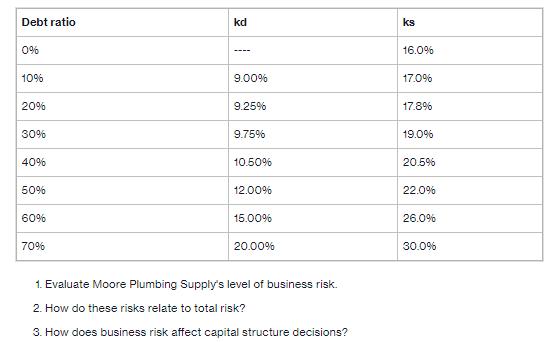Question
Tom spent the first few months on the new job trying to get a better handle on the bigger picture and puzzled over the company's
Tom spent the first few months on the new job trying to get a better handle on the bigger picture and puzzled over the company's historical balance sheets, income statements, and cash flow statements. One area that concerned him was the company's heavy reliance on equity financing. Moore Plumbing has a large line of credit and uses this and short-term debt to finance its temporary working capital requirements. However, it does not use any permanent debt capital. Other construction related retail and wholesale companies have between 30 and 40 percent of their long-term capitalization in debt. Tom wonders why other companies use more permanent debt and what affect adding long-term debt would have on the company's earnings and stock price. Tom met with the company's vice president of finance, Walt Harriman, and learned that the company projected its earnings before interest and taxes to be $12 million for the next year with projected tax rate to be 40 percent. Tom next talked to the company's investment bankers and discovered that the company's cost of equity was 16 percent. Since the company did not use debt or preferred stock financing, this also represented the company's current weighted average cost of capital.
The investment bankers indicated that the company could issue at least $30 million of long-term debt at a cost of 9 percent. The company bonds would be highly rated and would carry a low coupon because the company easily service the debt. Because of Stan's depression experience and his early involvement in funding the initial operation, the company not only avoided debt but also followed a policy of paying out most of its earnings as dividends, Stan was frequently quoted saying "a company with a high dividend policy rarely declared bankruptcy." In lieu of using retained earnings to reinvest in the company, the company used accounts payable and deferred taxes to meet its operating capital needs and issued capital was purchased by members of the Moore family and they currently hold 75 percent of the outstanding equity.
Tom is interested in gaining additional insights into capital structure issues and has asked Walt to brief him in the area. He wants a basic review of the terminology but is particularly interested in the impact of different types of risk and in understanding of the better-known financial theorists. Walt knew that Tom could grasp complex issues quickly and felt that a thorough discussion of Modigliani and Miller's work would be appropriate. He also felt that Miller's addition of personal taxes to the earlier models would be good to cover, and he determined that a good approximation of personal tax rate on debt income was 28 percent and for stock income was 20 percent. He decided to add the more recent considerations of financial distress, agency costs, and information asymmetry for a comprehensive overview. To help with this analysis, Walt developed the following estimates for cost of debt and cost of equity that included an increasing premium for financial distress and agency costs as the debt ratio increases.

Debt ratio 0% 10% 20% 30% 40% 50% 60% 70% kd ---- 9.00% 9.25% 9.75% 10.50% 12.00% 15.00% 20.00% 1. Evaluate Moore Plumbing Supply's level of business risk. 2. How do these risks relate to total risk? 3. How does business risk affect capital structure decisions? ks 16.0% 17.0% 17.8% 19.0% 20.5% 22.0% 26.0% 30.0%
Step by Step Solution
3.40 Rating (150 Votes )
There are 3 Steps involved in it
Step: 1
1 Evaluate Moore Plumbing Supplys level of business risk Moore Plumbing Supply is a constructionrela...
Get Instant Access to Expert-Tailored Solutions
See step-by-step solutions with expert insights and AI powered tools for academic success
Step: 2

Step: 3

Ace Your Homework with AI
Get the answers you need in no time with our AI-driven, step-by-step assistance
Get Started


